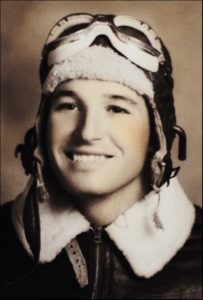
Bill Hailey
B-24 Co-pilot
in Europe
Bill Hailey
First Lieutenant
1941–1946

1st Lt. Bill Hailey
Chickahaw, OK, 1943
I lost an engine. I knew those German fighters would get all over us as we had slowed our speed. Two Army Air Corps Curtiss P-40 Warhawk fighters appeared out of nowhere—one was on each wing tip. We had an escort home; they looked like angels.
I was born in 1922 and grew up in Houston, Texas. My parents moved to San Antonio during the war. My dad was in the building business and you couldn’t get building supplies in Houston, but you could in San Antonio. In 1941 I was enrolled at Baylor University in what they called the Army Air Corps College Training Detachment. In February 1943, my junior year, I was called to active duty and sent to Sheppard Field in Wichita Falls, then to Centenary College for additional detachment training.
We went through flight training in Pueblo, Colorado. They assigned me to a crew as a co-pilot on a B-24. It wasn’t a pretty plane, but it sure could make the flights we needed. In October 1944, we shipped out to South Hampton, England. I was in the 453rd Heavy Bombardment Group. The first night I was in England, the air raid sirens went off. It was buzz bombs—putt, putt, putt. They didn’t bomb our base; they went past us.
One memorable mission was flying down to southern Germany where Hitler moved his capital. We began bombing his temporary capital when I lost an engine. I knew those German fighters would get all over us as we had slowed our speed. Two Army Air Corps Curtiss P-40 Warhawk fighters appeared out of nowhere—one was on each wing tip. We had an escort home; they looked like angels.
I remember our mission on January 1st, 1945. It was the Battle of the Bulge. Only 2 of 44 planes got up from the air base because of the weather. We flew and hit the Germans just on the other side of the Bulge. It was the only time we did troop bombing. We were usually bombing their airfields, manufacturing plants, and munitions plants. During the battle we were hitting a major crossing of the big river there. We bombed 8 out of 10 days which was a lot more than usual because of the bad weather in northern Europe. It sure was cold. You had to wear this Mae West vest to keep you from drowning in case we went down in water. When I went down to a lower altitude to drop the bombs, there would be an ice pack on my chest due to the moisture in my breath. I had electric gloves, electric boots, electric suit, so I never got cold even though we had no heat in the airplane at all. We all had that heated suit; thank goodness they worked. It was cold for an old Texas boy.
I was overseas from October 1944 to June 1945, got discharged in 1945 and came back to the States. The best day I had in the Army Air Corps was when the war ended and we flew back home. We landed Friday, June 13, 1945. We got off the plane, and every one of us knelt down and kissed the ground. I happened to be in San Antonio when I got discharged. Went right back to Waco and enrolled in school. I graduated Baylor in 1947, and in 1949 got my Doctor in Law. I took the bar and luckily, I passed.
I joined my uncle and cousin as an attorney. They were in a big home building business. I decided I wanted to practice law, so I took a job with an attorney in Amarillo for a year. That didn’t work out, so I came back to San Antonio. After a few years, my dad and I took over the home-building and subdividing business in the southeast part of San Antonio by Brooks Field. We built quite a few homes. I practiced law until I was 84 and got my 50 years bar button. {09-27-2016 • San Antonio, TX}